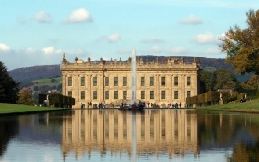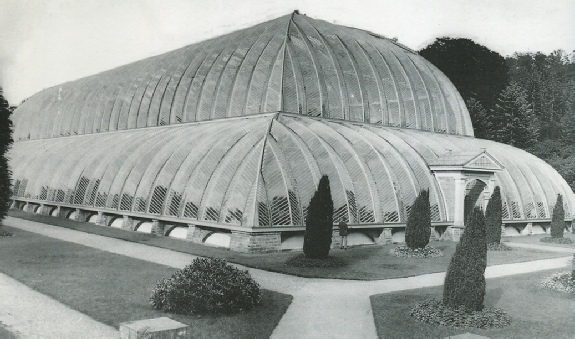Home of the Dukes of Devonshire
Chatsworth & Joseph Paxton
In 1823 Joseph Paxton secured a position at the Horticultural Society’s Chiswick Gardens where he came to the attention of the 6th Duke of Devonshire who owned the neighbouring Chiswick House. Impressed by Paxton’s work the Duke offered Paxton a position at Chatsworth and in 1826 he took up his role as head gardener.
Paxton worked tireless for the Duke and redesigned the gardens from an informal landscape to the more formal layout seen today. A collection of conifers were planted to create a pinetum which developed to an area of some forty acres. A stunning rock garden, a water fountain which reached a height of 90 metres and the development of glasshouses were all the work and inspiration of Paxton.
In 1841 an Improvement Commission in Birkenhead proposed the idea of a public park. As a result, 226 acres of poor quality marsh land was purchased with public money and Birkenhead Park was born. Paxton, recognised for his work at Chatsworth and who had already worked in Liverpool on the creation of private grounds known as Princes Park, was asked to design the new park. 125 acres were designated for public use with the remaining acres to be sold for private residential development. The proceeds from the sale of the building plots were sufficient to recoup all the costs incurred by the purchase of the land and the construction of the park. An Improvement Committee chaired by William Jackson was set up to supervise the development of the park and in August 1943 Paxton was engaged to design and construct the park at a fee of £800. Joining Paxton from Chatsworth were Edward Kemp a gardener and John Robertson an architect.Sir Joseph Paxton died in 1865 and is buried at St Peter's Church, Edensor Derbyshire.
Edward Kemp
Edward Kemp had served as an apprentice gardener at Chatsworth in the 1830’s with Edward Milner who had been with Paxton at Princes Park. Kemp came to Birkenhead Park in 1843, supervised the preparatory work and oversaw the day to day implementation of Paxton’s plans. By 1845 when Paxton’s work was nearing completion, he recommended to the Commissioners that Kemp be retained as the Park’s first superintendent and that he be provided with a house. This was accepted and Kemp moved into the Italian Lodge.
Kemp was not just an ordinary gardener but a well educated man who went on to become well respected in his own right as a designer of gardens and landscapes. Taking on numerous commissions of work he requested that his salary as Park superintendent be reduced by one third to £100 per annum thus ensuring his employer's agreement that he continue with private work. By way of a contribution to the Park, Kemp built his own house in 1859 (74 Park Road West) and was thus able to move out of his free accommodation at the Italian Lodge. Very early connections between Birkenhead Park and New York were made when, in 1857, the New York Park Commission consulted Kemp on their plans for what is now known as Central Park. It is suggested that the Commissioners also offered Kemp the position of Park Superintendent, a post he did not take up.
Edward Kemp's work can also be found at Flaybrick Cemetery, Anfield Cemetery, Lymm Hall Lymm, Stanacres Raby,Stanley Park Liverpool, Hesketh Park Southport and many more.
Edward Kemp died in 1891 and was buried in Flaybrick Cemetery.
John Robertson
John Robertson was Paxton’s architectural assistant and had been at Chatsworth from about 1838. From 1829 he had worked with John Claudius Loudon and had drawn all the explanatory diagrams and designs from suggestions made by Loudon in his Encyclopaedia of Cottage, Farm and Villa Architecture. In 1833 Robertson published his own work entitled Supplement to Loudon's Designs for Dwellings in the Cottage Style, varying in Accommodation from Three to Ten Rooms Each, Besides Offices and was a well respect member of Loudon's staff.
In 1838 Robertson was in Derbyshire and Chatsworth records show that he was paid for the designs of ten cottages to form the new village of Edensor. The then current Duke of Devonshire did not like to see the village from Chatsworth and had instructed that a new village be built to house the residents after which the old village was to be dismantled. The designs are thought to be either of his own work or taken from Loudon's Encyclopaedia of Cottage, Farm and Villa Architecture. Remarkably, no two chimneys in the village are the same. In 1840 he joined the staff at Chatsworth and was with Paxton on his first visit to Birkenhead Park when Paxton wrote the following to his wife; "... I think I must have lost a lb of propriation for I walked at least 30 miles about to make myself master of the locality & it is not a very good situation for a park ad the land is generally poor but out of bad materials... indeed i am not altogether sorry that it is as it is for it will suit my ingenuity to work to overcome the difficulty...I am just going over the ground again with Robertson and Baily so that I shall have a bursting day again...I want time to consider well the plans for this new Park." (Markham Papers).
In Birkenhead Park the following buildings have been attributed to Robertson in association with Lewis Hornblower:
The Grand Entrance, Italian Lodge, Norman Lodge East, Norman Lodge West, 1 Cavendish Road, 27 Ashville Road, 78 Park Road West and the Roman Boathouse.
Robertson died in 1852 and like Paxton, he is buried at St Peter's Church, Edensor Derbyshire.


